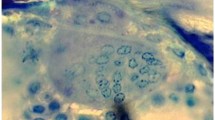Summary
Though some evidence suggests that bisphosphonates (BPs) act directly on osteoclasts to inhibit bone resorption, other evidence suggests that they inhibit the development of the osteoclast. We found an increase in osteoclast recruitment in 2-day-old mice given (3-amino-1-hydroxypropylidene)-1,1-bisphosphonate (APD). A threefold increase in 5-bromo-2′-deoxyuridine (BrdU)-labeled osteoclast nuclei was observed on mouse parietal bones 3 days after APD injection. This suggests that inhibition of osteoclast development is not an action of APD in mice of this age. The mechanism of the increased recruitment was investigated. As osteoclast progenitors were not detected on parietal bonesin vitro, we looked for an increase in circulating monocytes to account for the recruitment. No such increase was found, but when51Cr-labeled bone marrow was injected intraperitoneally into mice given APD there was an increase in accumulation of51Cr in calvaria and in femur and tibia over controls. This increase did not occur when51Cr-labeled erythrocytes or free51Cr was injected. We conclude that APD causes increased recruitment of osteoclast precursors by increasing the avidity of bone for hematopoietically derived cells.
Similar content being viewed by others
References
Rowe DJ, Hausmann E (1976) The alteration of osteoclast morphology by diphosphonates in bone organ culture. Calcif Tissue Res 20:53–60
Rowe DJ, Hays SJ (1983) Inhibition of bone resorption by difluormethylene diphosphonate in organ culture. Metab Bone Dis Rel Res 5:13–16
Gomes BC, Kaufman HW, Archard HO, Cangemi C, Guerra A (1986) Histological study of the inhibition of bone resorption in organ cultures by myoinositol-2-monophosphate. J Oral Pathol 15:54–58
Evans RA, Howlett CR, Dunstan CR, Hills E (1982) The effect of long-term low-dose diphosphonate treatment on rat bone. Clin Orthop Rel Res 165:290–299
Miller SC, Jee WSS, Kimmel DB, Woodbury L (1977) Ethane-1-hydroxy-1,1-diphosphonate (EHDP) effects on incorporation and accumulation of osteoclast nuclei. Calcif Tissue Res 22: 243–252
Marshall MJ, Wilson ASW, Davis MWJ (1990) Effects of (3-amino-1-hydroxypropylidene)-1,1-bisphosphonate on mouse osteoclasts. J Bone Miner Res 5:955–962
Flanagan AM, Chambers TJ (1989) Dichloromethylenebisphosphonate (Cl2MBP) inhibits bone resporption through injury to osteoclasts that resorb Cl2MBP-coated bone. Bone Miner 6:33–43
Flanagan AM, Chambers TJ (1991) Inhibition of bone resorption by bisphosphonates: interactions between bisphosphonates, osteoclasts and bone. Calcif Tissue Int 49:407–415
Sato M, Grasser W (1990) Effects of bisphosphonates on isolated osteoclasts as examined by reflected light microscopy. J Bone Miner Res 5:31–40
Carano A, Teitelbaum SL, Konsek JD, Schlesinger PH, Blair HC (1990) Bisphosphonates directly inhibit the bone resorption activity of isolated avian osteoclasts in vitro. J Clin Invest 85: 456–461
Boonekamp PM, van der Wee-Pals LJA, van Wijk-van Lennep MML, Thesing CW, Bijvoet OLM (1986) Two modes of action of bisphosphonates on osteoclastic resorption of mineralized matrix. Bone Miner 1:27–39
Löwick CWGM, van der Pluijm G, van der Wee-Pals LJA, Bloys van Treslong-de Groot H, Bijvoet OLM (1988) Migration and phenotypic transformation of osteoclast precursors into mature osteoclasts: the effect of a bisphosphonate. J Bone Miner Res 3:185–192
Cecchini MG, Felix R, Fleisch H, Cooper PH (1987) Effect of bisphosphonates on proliferation and viability of mouse bone marrow-derived macrophages. J Bone Miner Res 2:135–142
Ash P, Loutit JF, Townsend KMS (1980) Osteoclasts derived from haematopoietic stem cells. Nature 283:669–670
Hughes DE, MacDonald BR, Russell RGG, Gowen M (1989) Inhibition of osteoclast-like cell formation by bisphosphonates in long-term cultures of human marrow. J Clin Invest 83:1930–1935
Marshall MJ, Davie MWJ (1991) An immunocytochemical method for studying the kinetics of osteoclast nuclei on intact mouse parietal bone. Histochem J 23:402–408
Addison WC (1979) The distribution of nuclei in imprints of feline osteoclasts. J Anat 129:63–68
Fischman DA, Hay ED (1962) Origin of osteoclasts from mononuclear leukocytes in regenerating newt limbs. Anat Rec 143: 329–334
Marie PJ, Holt M, Garba M-T (1985) Inhibition by aminohydroxypropylidene bisphosphonate (AHPrBP) of 1,25(OH)2D3-induced stimulated bone turnover in the mouse. Calcif Tissue Int 37:268–275
de Vernejoule MC, Pointillart A, Bergot C, Bielakoff J, Morieux C, Laval Jeantet AM, Miravet L (1987) Different schedules of administration of (3 amino-1-hydroxypropylidene)-1,1-bisphosphonate induce different changes in pig bone remodelling. Calcif Tissue Int 40:160–165
Walker DG (1975) Control of bone resorption by hematopoietic tissue. J Exp Med 142:651–663
Tinkler SMB, Linder JE, Williams DM, Johnson NW (1981) Formation of osteoclasts from blood monocytes during 1 alpha-OH Vit D-stimulated bone resorption in mice. J Anat 133:389–396
Hattersley G, Kerby JA, Chambers TJ (1991) Identification of osteoclast precursors in multilineage hemopoietic colonies. Endocrinology 128:259–262
Bijvoet OLM, Frijlink WB, van der Linden KJIEH, Meijer CJLM, Mulder H, van Paassen HC, Reitsma PH, te Velde J, de Vries E, van der Wey JP (1980) APD in Paget's disease of bone. Arthritis Rheum 23:1193–1204
Adami S, Bhalla AK, Dorizzi R, Montesanti F, Rosini S, Salvagno G, Lo Cascio V (1987) The acute-phase response after bisphosphonate administration. Calcif Tissue Int 41:326–331
Fenton AJ, Gutteridge DH, Kent GN, Price RI, Retallack RW, Bhagat CI, Worth GK, Thompson RI, Watson IG, Barry-Walsh C, Matz LR (1991) Intravenous aminobisphosphonate in Paget's disease: clinical biochemical, histomorphometric and radiological responses. Clin Endocrinol (Oxf) 34:197–204
Author information
Authors and Affiliations
Rights and permissions
About this article
Cite this article
Marshall, M.J., Holt, I. & John Davie, M.W. Osteoclast recruitment in mice is stimulated by (3-amino-1-hydroxypropylidene)-1,1-bisphosphonate. Calcif Tissue Int 52, 21–25 (1993). https://doi.org/10.1007/BF00675622
Received:
Revised:
Issue Date:
DOI: https://doi.org/10.1007/BF00675622




